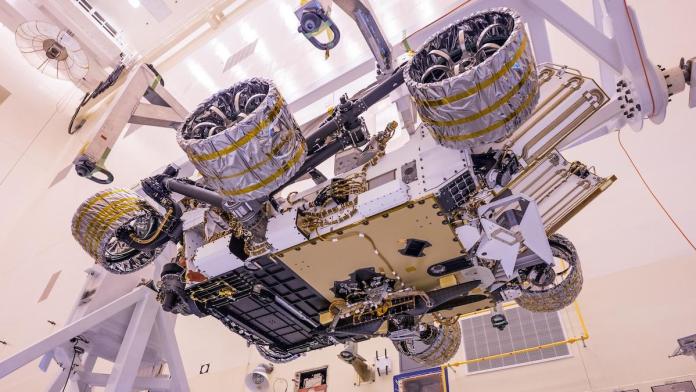In the first official weather outlook the planned launch this week of NASA’s Mars 2020 Perseverance rover, meteorologists predict an 80 percent chance of favorable conditions to allow liftoff of an Atlas 5 rocket from Cape Canaveral Thursday.
United Launch Alliance ground crews plan to transfer the 197-foot-tall (60-meter) Atlas 5 rocket to its launch pad Tuesday morning to begin preparations for an early morning countdown Thursday. The $2.7 billion Mars 2020 mission is scheduled for launch from pad 41 at Cape Canaveral Air Force Station during a two-hour window Thursday opening at 7:50 a.m. EDT (1150 GMT).
The first forecast for the mission issued by the U.S. Space Force’s 45th Weather Squadron indicates there is an 80 percent chance of acceptable conditions for liftoff of ULA’s workhorse Atlas 5 launcher Thursday.
“For launch day Thursday, overall conditions are favorable,” the forecast team wrote. “However, an isolated shower just offshore and some mid-level clouds along the coast are likely as a weak front off the coast of the southeast (United States) sags southward. Therefore, the primary concerns for launch day are the cumulus cloud and thick cloud layer rules.
Forecasters predict partly cloudy skies, a temperature of between 80 and 83 degrees Fahrenheit, and muggy conditions Thursday morning on Florida’s Space Coast.
For backup launch opportunities Friday and Saturday, forecasters expect similar conditions, with 90 and 80 percent chances of acceptable weather for liftoff each day.
NASA’s Perseverance rover and a compact drone named Ingenuity that will attempt to become the first rotorcraft to fly on another planet are buttoned up inside the payload shroud of the Atlas 5 rocket. The Mars-bound vehicles were stacked on top of the Atlas 5 on July 7, and engineers completed a series of electrical checkouts to verify the payloads were properly connected to the rocket.
On July 20, ground teams installed a plutonium-fueled nuclear power generator on the rover. The power source will provide electricity to the Perseverance rover throughout its mission, expected to last at least one Mars year — or nearly two Earth years — following its landing on the Red Planet on Feb. 18, 2021.
Carrying a sophisticated package of scientific instruments, a robotic arm, the Ingenuity Helicopter, 25 cameras, and the first microphones to record sound on the Red Planet, NASA’s Mars 2020 mission is the most advanced robotic explorer ever sent into deep space.
The Perseverance rover, developed and built at NASA’s Jet Propulsion Laboratory, will target a landing at Jezero Crater on Mars. Scientists believe the region was once home to an ancient river delta, providing an environment that could have sustained microbial life.
With its scientific instruments, Perseverance will test that hypothesis, providing researchers with a mobile geologic scout similar to NASA’s Curiosity rover, which has been driving across Mars at a different location since 2012.
A primary goal of the Mars 2020 mission is to identify and collect rock core samples for storage inside sealed, sterilized tubes for retrieval by a future robotic probe as soon as the late 2020s. That mission, conducted in partnership with the European Space Agency, will bring the specimens back to Earth as soon as 2031 for analysis in terrestrial laboratories, where scientists will scan the samples for the signatures of past life.
Email the author.
Follow Stephen Clark on Twitter: @StephenClark1.
– Advertisement –
